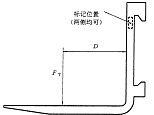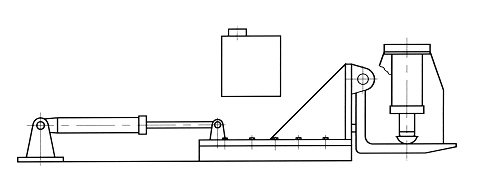Large Tonnage Forks and Their Detection Device
National Construction Machinery Quality Supervision and Inspection Center Chen Baoqiang
I. Introduction
As a crucial component of forklifts, forks have drawn increasing attention in terms of quality, especially after forklifts were classified as special equipment. This classification has imposed stricter requirements on the manufacturing and testing of forks. According to GB/T 5182-1996 "Technical Requirements and Tests for Forklift Forks," the performance of the fork must meet specific standards. Additionally, forklifts exported to the European Union require CE safety certification, which also mandates compliance with ISO 2330:1995. These two standards are largely aligned, particularly when it comes to testing large-tonnage forks (with a single fork weight of at least 5000 kg).
However, domestic detection devices for large-tonnage forks are almost nonexistent, creating significant challenges for both the inspection of special equipment and export processes. In response, the author has developed a fork detection device suitable for loads below 4000 kg and further designed a testing system for larger tonnage forks based on standard requirements.

Figure 1
II. Preliminary Design of the Testing Device
According to GB/T 5182-1996 and ISO 2330:1995, fork samples must undergo yield testing. For a single fork rated at 5000 kg or more, the test load FT is three times the rated lifting capacity C. For forks with a rated capacity exceeding 5000 kg, the test load is calculated as FT = G × R, where G is the rated lifting weight and R = 3 - 0.08(Q - 10), with R ≥ 2.5.
The testing procedure involves fixing the fork in the same manner as it would be mounted on a forklift, along with a length gauge to measure permanent deformation. The yield test should be performed twice without impact, with an interval of about 10 minutes between each loading. Each load is maintained for 30 seconds. The loading position is determined from the front surface dimension D of the vertical section of the fork (as shown in Figure 1). When the rated lifting capacity is less than 5500 kg, D refers to the load center distance; otherwise, it is specified by the manufacturer.

Figure 2
III. Composition of the Detection Device and Testing Principle
Based on the standard requirements, the schematic diagram of the detection device for forks weighing 5000 kg or more is illustrated in Figure 2. The device primarily consists of a loading mechanism, a fork positioning system, a load display unit, a hydraulic system, and measuring instruments.
The testing principle includes the following key steps:
1. The fork positioning device is fixed on the fork frame, typically a sleeve-type structure for large-tonnage forks. The frame must be simple yet capable of handling up to 100 tons. Different pin shaft sleeves are used to accommodate various fork sizes. The lower positioning blocks must be adjusted according to the fork specifications, with different thicknesses determined accordingly. The fork must be solid and free from bending, with its upper surface level.
2. The fork frame is installed on a slide rail, and the position of the fork and frame is adjusted using a cylinder at the tail end. Once the correct position is set, it is locked with fastening bolts. This ensures the correct load center distance or loading position.
3. The loading device includes a spherical pressure sensor, a frame, a load display unit, and a hydraulic station that powers the cylinder and piston rod. The hydraulic station must provide 20 MPa of pressure, with the cylinder outputting at least 80 tons. The pressure sensor range should reach 80 tons, and the display accuracy must be within 0.1%. A servo cylinder is recommended to ensure smooth movement and stable load application during testing.
4. After unloading, a length measurement device is installed on the side of the fork. Measurements are taken before loading (at the fork tip, with the measuring tool parallel to the fork) and again after 30 seconds of loading. The process is repeated after 10 minutes to check for any permanent deformation caused by the test.
IV. Determination of the Detection Device Design Plan and Requirements
Currently, the largest forklift in China can handle up to 45 tons. Therefore, the testing device must have a carrying capacity of at least 67.5 tons, ideally 80 tons. All brackets, forks, and related components must be checked for strength to meet loading requirements. Since the device operates under static load conditions, a smaller safety factor can be used during design.
The hydraulic station must ensure stable output force after loading, meaning the hydraulic system's pressure must remain consistent. A servo cylinder should be paired with the system to allow for smooth movement and constant pressure. The system should also include fine adjustment features.
The spherical pressure sensor should have self-aligning capabilities to ensure that the load is applied vertically to the top surface of the fork. The digital load display instrument should be placed near the hydraulic station to monitor the loading condition. Manual hydraulic valves help maintain a stable test load.
The fork frame rail can be designed as a dovetail type, allowing linear movement when adjusting the load position. The fixing bolts should be evenly distributed to ensure secure positioning. Due to the low resistance in longitudinal adjustment, a smaller cylinder diameter may be used.
Designing and manufacturing a large-tonnage fork detection device expands the testing range and fills a gap in domestic detection technology. It provides essential testing equipment for parts inspection in large-tonnage fork type tests, ensuring compliance with export inspection requirements and supporting the quality assurance of forklift products.
Protective Film For Aluminum,Blue Transparent Protective Film,Protective Film,Aluminum Plastic Film
Wuxi Xinhao Protective Film CO.,Ltd , https://www.cotton-balewrap.com